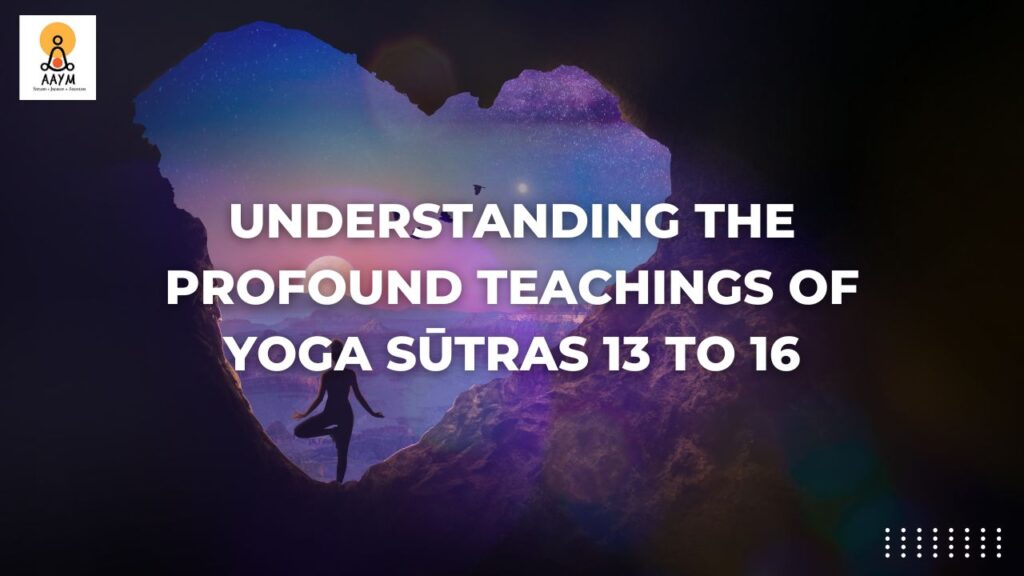Understanding the Profound Teachings of Yoga Sūtras 13 to 16
The timeless wisdom of the Yoga Sutras offers profound insights into the practice of yoga and its transformative effects on the mind. Verses 12 to 16, in particular, focus on the twin concepts of abhyāsa (consistent practice) and vairāgya (non-attachment). Here’s a deeper look at these verses, rendered in accessible language for a modern audience.
Verse 12: The Role of Practice and Disinterest
The Role of Practice and Disinterest “abhyāsa vairāgyābhyāṁ tannirodhaḥ” highlights that the cessation of fluctuations in consciousness is achieved through diligent practice and a disinterest in sensory experiences. In simpler terms, regular practice helps us reduce the mental noise that distracts us from achieving tranquility.
Verse 13: The Persistence in Practice
The Persistence in Practice In “tatra sthitau yatnaḥ abhyāsaḥ,” the emphasis is on the effort required to maintain the state of disinterest. It is a reminder that consistency in practice is crucial. To cultivate a steady mind, one must persistently work towards ignoring the pulls of the sensory world.
Verse 14: Long-term Commitment
Long-term Commitment “s tu dīrghakāla nairantarya satkāra āsevitaḥ dṛḍhabhūmiḥ” speaks of the firm grounding that comes from sustained practice over a long period, with reverence and dedication. This sutra assures us that perseverance in practice, when performed with respect and uninterrupted focus, builds a strong foundation for spiritual growth.
Verse 15: Mastering Non-Attachment
Mastering Non-Attachment The sutra “dṛṣṭa ānuśravika viṣaya vitṛṣṇasya vaśīkārasaṁjñā vairāgyam” describes vairāgya as the state where one is not tempted by either visible objects or those described in scriptures. It is a higher level of consciousness that allows one to remain unaffected by external influences and cravings.
Verse 16: Ultimate Dispassion
Ultimate Dispassion Finally, “tatparaṁ puruṣakhyāteḥ guṇavaitṛṣṇyam” tells us that the highest form of non-attachment comes when one transcends even the qualities of nature, realizing and resting in the true self or spirit beyond. Each of these verses coaxes us towards a life of greater awareness and lesser attachment. They teach us that through continuous and devoted practice, one can achieve a state of inner peace and ultimate liberation. This path, as laid out in the Yoga Sutras, is both challenging and rewarding, offering a blueprint for spiritual depth and fulfillment.
Embrace these teachings from the Yoga Sutras to embark on a transformative journey towards self-realization and peace.
The timeless wisdom of the Yoga Sutras offers profound insights into the practice of yoga and its transformative effects on the mind. Verses 12 to 16, in particular, focus on the twin concepts of abhyāsa (consistent practice) and vairāgya (non-attachment). Here’s a deeper look at these verses, rendered in accessible language for a modern audience.
Verse 12: The Role of Practice and Disinterest
The Role of Practice and Disinterest “abhyāsa vairāgyābhyāṁ tannirodhaḥ” highlights that the cessation of fluctuations in consciousness is achieved through diligent practice and a disinterest in sensory experiences. In simpler terms, regular practice helps us reduce the mental noise that distracts us from achieving tranquility.
Verse 13: The Persistence in Practice
The Persistence in Practice In “tatra sthitau yatnaḥ abhyāsaḥ,” the emphasis is on the effort required to maintain the state of disinterest. It is a reminder that consistency in practice is crucial. To cultivate a steady mind, one must persistently work towards ignoring the pulls of the sensory world.
Verse 14: Long-term Commitment
Long-term Commitment “s tu dīrghakāla nairantarya satkāra āsevitaḥ dṛḍhabhūmiḥ” speaks of the firm grounding that comes from sustained practice over a long period, with reverence and dedication. This sutra assures us that perseverance in practice, when performed with respect and uninterrupted focus, builds a strong foundation for spiritual growth.
Verse 15: Mastering Non-Attachment
Mastering Non-Attachment The sutra “dṛṣṭa ānuśravika viṣaya vitṛṣṇasya vaśīkārasaṁjñā vairāgyam” describes vairāgya as the state where one is not tempted by either visible objects or those described in scriptures. It is a higher level of consciousness that allows one to remain unaffected by external influences and cravings.
Verse 16: Ultimate Dispassion
Ultimate Dispassion Finally, “tatparaṁ puruṣakhyāteḥ guṇavaitṛṣṇyam” tells us that the highest form of non-attachment comes when one transcends even the qualities of nature, realizing and resting in the true self or spirit beyond. Each of these verses coaxes us towards a life of greater awareness and lesser attachment. They teach us that through continuous and devoted practice, one can achieve a state of inner peace and ultimate liberation. This path, as laid out in the Yoga Sutras, is both challenging and rewarding, offering a blueprint for spiritual depth and fulfillment.
Embrace these teachings from the Yoga Sutras to embark on a transformative journey towards self-realization and peace.

